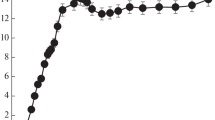Summary
Cell-free extracts from dormant spores of Phycomyces blakesleeanus can be activated by a heat shock, that means they show an enhanced level of L-lactate, ethanol, pyruvate and acetaldehyde compared to the untreated control.
Adding of d-glucose and d-fructose-1,6-diphosphate does not lead to an enhanced level of the four metabolic intermediates of glycolysis by activated and not activated cell-free extracts as well in respect of the corresponding control.
The turnover of 3-P-d-glycerate and 2-P-d-glycerate, however, is higher even by the untreated extract; the capacity of a heat shocked extract is insignificantly higher.
The turnover of d-glyceraldehyde-3-phosphate is remarkably better by an activated cell-free extract with regard to the not activated control.
Zusammenfassung
Homogenate hergestellt aus ruhenden Sporen von Phycomyces blakesleeanus lassen sich durch eine Wärmebehandlung aktivieren, d. h. sie produzieren im Vergleich zur nicht-wärmeaktivierten Homogenat-Kontrolle verstärkt Lactat, Äthanol, Pyruvat und Acetaldehyd. Die höchsten Werte liefert dabei eine Wärmebehandlung von 4 min bei 56°C.
Der Zusatz von d-Glucose und d-Fructose-1,6-diphosphat führt sowohl bei wärmebehandelten wie nicht-wärmebehandelten Sporenhomogenaten im Vergleich zur entsprechenden Kontrolle nicht zu einem erhöhten Anstau der vier untersuchten Glykolyseprodukte.
d-Glycerat-2-phosphat bzw. d-Glycerat-3-phosphat werden dagegen von einem unvorbehandelten Homogenat sehr gut umgesetzt; die Leistung eines wärmeaktivierten Homogenats ist unter entsprechenden Versuchsbedingungen nur geringfügig höher.
d-Glycerinaldehyd-3-phosphat wird dagegen von einem wärmeaktivierten Homogenat weitaus besser umgesetzt als von der nicht-wärmebehandelten Kontrolle.
Similar content being viewed by others
Literatur
Betz, A., Brinkmann, K., Hinrichs, R.: Welchen Informationswert haben in Rohextrakten gemessene Enzymaktivitäten für physiologische Probleme? Planta (Berl.) 80, 77–81 (1968).
—, Sel'Kov, E.: Control of phosphofructokinase (PEK) activity in conditions simulating those of glycolysing yeast extract. FEBS Letters 3, 5–9 (1969).
Furch, B.: Stoffwechselumsetzungen in Sporenhomogenaten von Phycomyces blakesleeanus nach Wärmeaktivierung. Ber. dtsch. bot. Ges. 82, 221–222 (1969).
Hefendahl, F. W.: Regulierungsmöglichkeiten im cellulären Stoffwechsel durch Kompartimentierung. Z. Pflanzenphysiol. 60, 370–382 (1969).
Rudolph, H., Krüger, Ch., Siebelds, J.: Über Änderungen des Brenztraubensäure-und ATP-Gehaltes wärmeaktivieter Sporen von Phycomyces blakesleeanus. Z. Pflanzenphysiol. 55, 415–428 (1966).
—, Ochsen, B.: Trehalose-Umsatz wärmeaktivierter Sporen von Phycomyces blakesleeanus. VI. Beitrag zur Kausalanalyse der Wärmeaktivierung von Pilzsporen. Arch. Mikrobiol. 65, 163–171 (1969).
Author information
Authors and Affiliations
Rights and permissions
About this article
Cite this article
Rudolph, H., Furch, B. Untersuchungen zur Aktivierung von Sporenhomogenaten durch Wärmebehandlung. Archiv. Mikrobiol. 72, 175–181 (1970). https://doi.org/10.1007/BF00409522
Received:
Issue Date:
DOI: https://doi.org/10.1007/BF00409522



